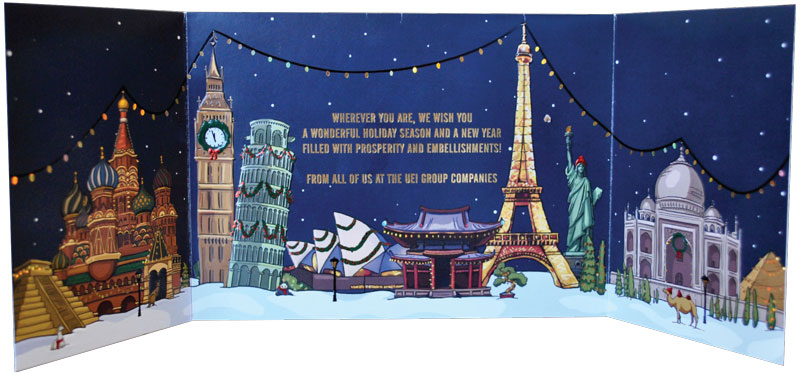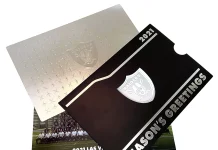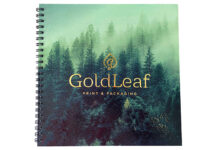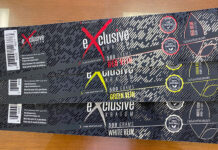By Lara Copeland, contributing editor
PostPress
UEI® Group Companies, Overland Park, Kansas, has worked with the University of Kansas’ Department of Design for nearly 20 years, having formed a symbiotic relationship to provide students with the opportunity to learn how their designs can develop into a finished product. “It is a unique, special program where students receive invaluable printing production knowledge and use with a practical application in a design of their own creation,” expressed Jim Hutchison, senior vice president of the UEI® Group Companies.
Each year the students are tasked with designing the corporate UEI Group holiday card, keeping in mind the enhancements offered by UEI Group, including engraved foil and embossing dies as well as decorative foils and glitter to create the final piece. Once students make their submissions, the UEI® Group chooses corporate staff from various departments to judge the students’ designs. Once the winner is selected, the holiday card is produced and distributed worldwide to companies of all sizes, and the student is given samples of the card for their portfolio. The 2018 winner was designed by Abra Shirley.
Brightmarks, LLC, a print and packaging enhancement company, brought Shirley’s design to life. On the front of the card and spread across the opening of the gate fold is the globe. Depicted as an ornament, the globe features land masses that are stamped in gold foil. A red foil stamped ribbon is looped through and tied around the ornament hanger and drapes down the sides of the globe-shaped ornament. Stamped in gold below the globe, the card says “Joy to your world.” Several world-famous landmarks are printed in 4-color process against a dark sky and snow-covered ground on the inside of the three-paneled card. These landmarks include the Kremlin, London Tower, Sydney Opera House and Statue of Liberty, to name a few. Strewn about the peaks of these landmarks is a string of gold lights stamped in a gold holographic foil. The greeting on the center panel inside is stamped in gold metallic.
A total of five Kluge EHD presses were used to complete the project. The multi-level emboss die was set-up on one machine in register with the printed elements of the design. The first four applications of foil were stamped on each of four separate Kluge EHD presses. Each application was set-up using the machine that was embossing as a check for register of the position. Sheets were taken from one machine to the next until the first four foils were applied. Periodic pulls were done and fully embossed to ensure registration was maintained. A spot UV soft touch was applied following the fourth foil pass, and a fifth final foil pass was completed after the UV was applied. Then, the final embossing of the sheets was performed.
According to David Hutchison, CEO of Brightmarks, the print format selected was 14×20 running one up on a Heidelberg SM52-5 color press with AQ coater. “All of the foil stamp passes were performed using Universal Engraving heat-compensated copper flat stamp dies, some with Unifraxion® pattern details,” he said. He explained that the compensation was to match the operating temperatures of the respective foils.
Next, the spot UV soft touch was screen coated over the entire front and inside of the cards. Hutchison said, “The screen was created using a distorted film output internally, matched to the printed sheet.” Then the embossing was completed on a 14×22 Kluge EHD, and the embossing die was heat-compensated to the expected embossing temperature. “The embossing counter was a precast counter,” he added.
All foils for the project were provided by Infinity Foils, Inc., a UEI Group Company. “Choosing several different foils to further enhance the card and design aspects was key,” said Nicole Mercer, marketing for the UEI® Group Companies. The grades of foil were then selected by the application and what they were stamping. “A gloss green pigment foil (PG360) was chosen for the greenery sprinkled throughout the card, and it was paired with a beautiful metallic (45 shade) in all of the right spots. To get the special twinkle, Infinity® Foils, Inc., included the perfect gold holographic foil (41-97) next to a rich-black foil (99). It then was topped off by a gold that brought out all of the Unifraxion® excellence and text detail (867).”
Finally, the cards were folded and glued. The panels were intentionally duplexed to hide the reverse image of the emboss. The choice to duplex the panels made the print and processing one-sided, which also assisted in maintaining register and matchups. The face panels were diecut loose to facilitate the gate fold hinge on the front of the card. Hutchison said the design could be folded automated or by hand.
The card features tight registration in several areas where the foil registers to the print. Hutchison said tight register projects start with a good, well-maintained printing press. The small format offset presses minimize sheet distortion and offer the most control of sheet-to-sheet print placement. “The printing press operator must practice good process procedures,” he stated. “This includes ensuring that the travel of the sheet into the grip and guide are consistent and true.” He also noted that it is important to understand the foil selection to properly call out the heat compensations for the hot stamp. The paper selection will define the embossing temperature, and thus, the heat compensation rate of the embossing tooling. Likewise, the hot stamp and emboss press operator must ensure good practices and operation of side guide mechanisms.
A card that is created through collaborative efforts from various companies could create challenges in design and production; however, despite the complexity of UEI’s holiday card, there were very few challenges with its production. “Pre-planning eliminated any issues, and it was produced according to plan,” said David Hutchison. Jim Hutchison added, “Our UEI® Group team immensely enjoys the process of helping the students, and they continue to impress us year-over-year with their enthusiasm and creativity.”





